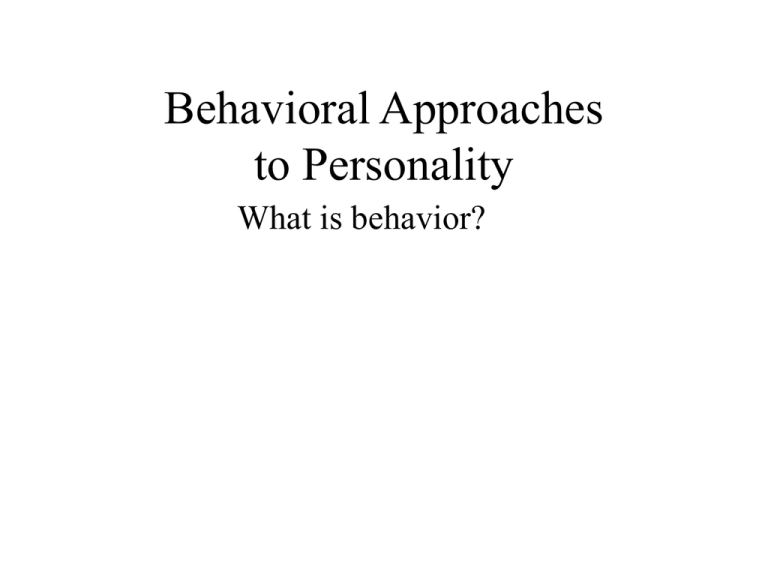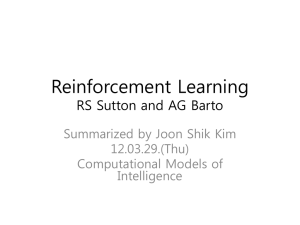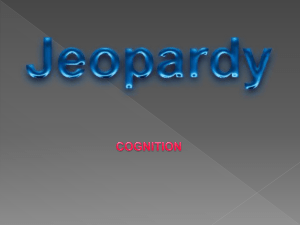August 5 - Behaviorism
advertisement

Behavioral Approaches to Personality What is behavior? Ivan Pavlov (1849-1936) Classical Conditioning CS UCS UCR UCS = unconditioned stimulus CS = conditioned stimulus UCR = unconditioned reaction CS CR UCS = conditioned reaction Edward Thorndike (1874-1949) Law of Effect: “Of several responses made to the same situation, those which are accompanied or closely followed by satisfaction to the animal will be more firmly connected with the situation, so that, when it recurs, they will be more likely to recur.” Cat in “puzzle box” John B. Watson (1878-1958) • Founder of behaviorism “Psychology as the Behaviorist Views It” (1913) • Influenced by Pavlov, Thorndike • Emphasized the importance of objective methods • Focus on animal studies • Focus on overt behavior Clark L. Hull (1884-1952) • Behavior is a function of the environment AND the properties of the organism (e.g. needs, cravings, drives) • Stimulus + Response = Habit • Habits get formed depending on the outcomes of the response (punishment/reward) • Habits form if certain responses to certain stimuli are rewarded Dollard & Miller “in order to learn one must • want something (drive - e.g. hunger) • notice something (cue - e.g. lever) • do something (response - e.g. push) • and get something (reward - e.g. get food)” • Differentiation: – primary drives (biological - e.g. hunger) – and secondary drives (learned - e.g. money) Dollard & Miller: Personality Development • Three basic characteristics of infant: – specific reflexes – innate response hierarchies – primary drives • Four crucial situations: – – – – feeding situation cleanliness training early sexual development anger anxiety conflicts Psychoanalysis Basic Units of Research Individual Differences Biological Influences Societal Influences View of Behavioral Data Behaviorism B.F. Skinner (1904-1990) • Differentiated between different theorists Drive Stimulus Response Outcome • Theory of operant conditioning • Based on Thorndikes “Law of Effect”: Depending on the type of reinforcement, specific changes in behavioral frequency are likely to occur • Experiments with different reinforcement schedules (focus on rats & pigeons) Skinner Box • positive reinforcement (reward) increased behavior • negative reinforcement (remove aversive S) increased behavior • extinction (no reward) decreased behavior • punishment (aversive S/remove reward) decreased behavior Reinforcement Schedules • Consistent - reinforcement every time • Ratio schedules number of responses – fixed ratio (e.g. every fourth response) – variable ratio (e.g. probability = .25) • Interval schedules time interval – fixed interval (e.g. every 4 minutes) – variable interval (e.g. on avg. every 4 mins) • Premack Principle – behaviors differ in relative probability – more probable behaviors can become reinforcers for less probable behaviors • Superstitious Behavior – animals are reinforced at random – soon they start to repeat behavior that coincided with reinforcement • Belongingness/Biological Preparedness – stimulus - response patterns are learned more easily if they are biologically related – e.g. food poisoning Educational Use of Learning Mechanisms • Identify problematic behavior • Identify stimuli that are associated with the behavior • Identify responses and their outcomes (punishment, reward, etc.) • What “drives”, needs, goals may motivate the behavior? • Define alternative behavior • Formulate an intervention to change the behavior (be specific: which reinforcement schedules etc.) (Karen Pryor: Don’t shoot the dog) The Skinnerian Tradition • Radical behaviorism: Focus on observable behavior (no assumption about internal state) • stimulus anxiety avoidance • stimulus avoidance/anxiety • Accused introspectionists of circular reasoning • Dismissed personality as an unscientific concept and challenged notions of individual freedom “Beyond Freedom and Dignity” (1971)











